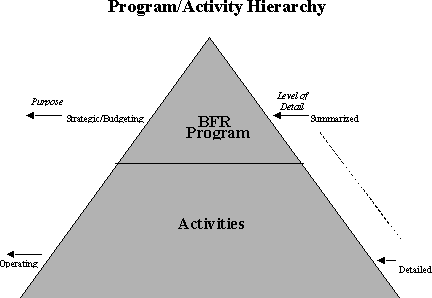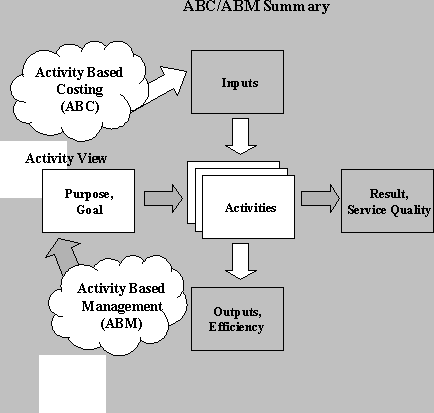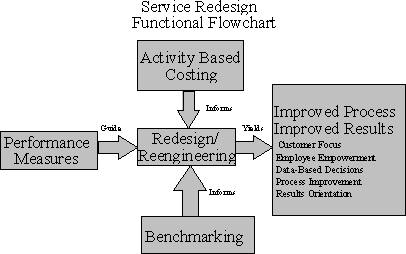
Introduction | What's New? | Managing for Results | Budgeting for Results | Accounting for Results | Auditing for Results | Courses | GASB 34 Implementation | Contact Us
|
|
ACCOUNTING
FOR RESULTS: |
|
OVERVIEW
Last
Updated: 12-15-04
Much has been written about knowing the costs of providing your services. Stephen Goldsmith, the former Mayor of Indianapolis, may have said it best:
"If government doesn't provide its customers with a dollar's worth of service for every dollar it takes in taxes, then it isn't helping them out--it's ripping them off. Activity Based Costing is a fundamental component of our city's comprehensive effort to link costs and outcomes, and create a budget that our customers can easily review."
More and more governments are costing their services. This section discusses the concepts of costing government services and describes the two most frequent methods of costing government services: general ledger cost accounting and activity based costing proprietary software.
Richard Green and Katherine Barrett wrote in the March 2000 edition of Governing Magazine that "Governments are finally beginning to figure out how to develop solid figures for the costs of the services they provide". They quoted Mark Abrahams in the same edition saying that "Not only are more governments trying to figure out how to develop solid cost figures for the services they provide, most governments have the capacity to do this, if they want to." Let's repeat that. Most governments have the capacity to cost government services now, if they want to do it. How? Through their general ledger system or activity based costing proprietary software.
Activity Based Costing (ABC) is a methodology that assigns costs to
activities and outputs based on the activities' consumption of resources.
For a detailed discussion on activity based costing concepts and a practical
implementation, click on the State of Iowa's Activity Based Costing
Manual authored by Mark Abrahams at www.dom.state.ia.us/state/budget_proposals/files/Activity_Based_Costing_Guide.pdf.
For a shorter discussion, click on "Activity Based Costing: Illustrations
from the State of Iowa" www.dom.state.ia.us/state/budget_proposals/files/Activity_Based_Costing_Article.pdf
, an article co-authored by Mark Abrahams and Mary Reavely. Both
these documents provide practical guidance on the concepts of ABC as
well as how to implement ABC in a government setting. While the documents
discuss the State of Iowa's experience, the concepts and implementation
steps are applicable to all governments. ABC is the tool used to identify
the costs of providing government services. ABC data provides information
about an activity: how many resources are consumed by an activity as
well as why those resources are used. Activity Based Management (ABM)
uses the ABC data and focuses on the management of the activity to continuously
improve the efficiency of the activity (providing the outputs at a lower
cost) and the effectiveness of the activity (providing quality services
that contribute positively to a result). ABM includes resource allocation,
activity flow, and performance measurement analyses. Activity based
data empowers state government managers and front-line employees to
redesign processes or to apply process improvement techniques to reduce
cost, improve customer satisfaction, enhance accuracy, reduce response
time, or otherwise improve efficiency and effectiveness.
Costs and Activities
There are two fundamental
components of ABC: costs and activities. Each of these components is
briefly discussed below. Costs are based on resources or inputs, for
such items as personal services, materials, office supplies, equipment,
and the like. The second major component of ABC is activity. Activities
are the steps or sequences of actions that convert inputs to outputs.
Activities have a set of three distinct characteristics that define
them. Every activity has 1) inputs, 2) a sequence of actions in the
middle that occupies a period of time, and 3) an output. An output may
be something other than a product or service, e.g., a student graduating
with a specific set of skills, and a certain level of competencies and
knowledge. 
Activity-Based Costing recognizes a hierarchy of operations. Each level in the hierarchy is an aggregation of the levels below it. Agencies will define an activity at a level deemed appropriate for the costing objective to be achieved. The most difficult part of analyzing costs is framing the activity at the most appropriate level of detail to satisfy the costing objective. The amount of detail should be no greater than required for the purpose for which the data are to be used. For example, Accounts Payable could be identified as an activity and costed. Or, Accounts Payable could be split into smaller activities such as receiving invoices, cutting checks, and mailing checks. Or the activity to be costed could be framed at a level well above Accounts Payable, so that Accounts Payable was only one small aspect of the larger activity.
As another example, the PROMISE JOBS program consists of the following four activities: Orientation and Assessment, Job Club, Training and Job Search. Each activity has related resources of personnel, materials, equipment and the like and converts the inputs to outputs. These activities have a common purpose: The purpose of the PROMISE JOBS program is to provide employment and training opportunities to welfare recipients so that they can become self-sufficient and leave public assistance. Each of the activities contributes to this purpose.
Another example is the Health Department's Licensing program. The licensing program consists of many activities such as License Renewal and License Maintenance within the BFR Public Protection Program. Each one of these activities contributes to maintaining quality health services and facilities for Iowans.
A final example is the DOT Paint Crews who conduct three activities: Center Line, Edge Line, and Curb, Island, and Miscellaneous. The Paint Crews will serve as the full cost methodology example in the Iowa ABC Handbook (Chapter 5).
Detailed cost information on activities benefits operational managers and assists them in improving operations. Summary cost information on activities provides information for program managers for budgeting and other purposes. Simply increasing awareness of costs and the cost structure of your operation can lead to efficiency improvements and greater cost discipline. You need to identify the activity consistent with your costing objective. Another way to identify the costing objective is to ask why you are doing the ABC. What is the business need for the information?
The keys are flexibility and adaptability. Be sure your costing objective is determining the way to define your activity for ABC purposes.
DEFINING YOUR COSTING OBJECTIVE
Why do you need
ABC? What is your costing objective? Are you getting ready to establish
rates to recover your costs of providing a service?  If
so, you will need total costs to facilitate your rate setting objective.
Will you be preparing a managed competition bid or looking to outsource
or privatize a service? If so, you will need total costs, less unavoidable
costs (such as the Department Director) to achieve your costing objective.
What about service redesign or process improvement? If you are undertaking
a service redesign or process improvement project, you will need comparable
costs of the existing process and the redesigned or improved process
to see if you achieved a cost saving. Are you getting ready to prepare
an activity based budget to submit for? Then you will need budgeted
estimated costs at the activity level. A summary of the business and
costing objectives follow:
If
so, you will need total costs to facilitate your rate setting objective.
Will you be preparing a managed competition bid or looking to outsource
or privatize a service? If so, you will need total costs, less unavoidable
costs (such as the Department Director) to achieve your costing objective.
What about service redesign or process improvement? If you are undertaking
a service redesign or process improvement project, you will need comparable
costs of the existing process and the redesigned or improved process
to see if you achieved a cost saving. Are you getting ready to prepare
an activity based budget to submit for? Then you will need budgeted
estimated costs at the activity level. A summary of the business and
costing objectives follow:
|
Business
Objective
|
Costing
Objective
|
|
Rate
or Fee Setting
|
Total
Costs(all direct and indirect costs)
|
|
Managed
Competition
|
Avoidable
Total Costs(all direct and indirect costs less those costs that
would not be avoided if the activity was outsourced)
|
|
Cost
Awareness
Process Improvement Reengineering Benchmarking |
Comparable
Costs(a flexible concept: those costs that are most easily determined;
costs over which the work unit has the most control; direct cost
total that can most easily be compared to other providers' direct
costs)
|
|
Activity
Based Budgeting
|
Budget
Estimates
|
Some of these reasons for performing ABC require a greater degree of exactness than others. And the chart above is not exhaustive. You may have other reasons to do ABC. The important point is to tailor your ABC to your business objective. Tailoring is important so that you achieve the level of accuracy and precision that you need, but do not waste resources by going further than needed. In balancing these demands, you should also be mindful of the ongoing data gathering and tracking requirements of your ABC. An ABC system that is too complex or cumbersome will not be used.
Cost View
ABC costing assigns resources (inputs) that are consumed (activities) to produce certain outputs (counts of what was produced). ABC assigns or allocates costs to activities based on some rationale. Costs are assigned to activities based on the activities' consumption of resources. Activity costs are then assigned to outputs based on their use of activities. This is known as the cost assignment or cost view.
 |
For example, salaries, material, and equipment are assigned to various activities to determine the costs of the activities that are then divided by activity outputs to derive cost per unit of output.
Activity View
ABC also provides an opportunity to understand how resources are expended to achieve results. The ABC process allows personnel to view the flow of tasks within an activity to understand how results and service quality are achieved. A task by task flow chart or outline of the activity allows deeper insights into how an activity works. This concept is called the "activity view." This view looks at the activity from the customer's or stakeholder's perspective. This view explains the why or why not of an activity's timeliness, accuracy or cost effectiveness and identifies how much was performed (number of units produced) as well as the inputs and efficiency of the activity. Activity performance measures of input, output, efficiency and service quality are aligned to the program results measure. The activity view feeds into Activity Based Management and leads to process improvement, service redesign, or other ways to continuously improve activities or processes.
 |
ABC Adds Value
The focus
of ABC and ABM is on activities and their outputs/results. Activity based
cost data provides more informative reports than the traditional line-item
or organizationally based accounting reports produced by current accounting
systems. These traditional reports provide important information for the
line item or organizational framework they were intended to address. Activity-based
costing however cuts through or supplements the traditional costing reports
to mirror what was actually done. It presents the same information by
activity to see how the resources are spent. ABC shows what it actually
costs to produce a given output or result. ABC also directly links service
levels with costs through unit costs. 
Seeing the cost data in this form usually leads to action. Sometimes, viewing ABC data is the first time program managers and program staff have seriously considered costs. This awareness alone often leads to cost cutting or reallocations from less to more productive resource use.
Another common response is an analysis of spending. ABC data makes it easier to see that some parts of the activity add more value to the results for less cost or vice versa. These cues naturally lead to process improvement and reengineering changes.
Comparing unit costs across different groups doing the same tasks, or across regional offices, leads to the obvious question: Why are there differences? Again, the answers to that question often lead to greater efficiencies and effectiveness as the operations with the best data share their best practices with the other groups or offices. Similarly, comparing unit cost information with comparable data from other public or private sector partners allows us to benchmark our performance. That benchmarking too supports process improvement, reengineering, and other decision making.
Service Redesign
Service Redesign begins with identifying core processes. For each core process identified, performance measures of input, output, efficiency and service quality are developed, the cost of the process is calculated, and benchmarking against a standard of excellence is initiated. ABC supports Service Redesign by costing activities. Using the measures, current costs, and benchmarking information, a redesign/re-engineering effort is undertaken. The post redesign/re-engineering performance and costs are then compared with the benchmark and an evaluation is conducted.

The real value in ABC and ABM is to view cost data from the perspective of what people and equipment do to satisfy customers and other stakeholders. By focusing on activities rather than line items or organizations, ABC makes it possible for personnel to better manage, understand and improve a process or activity, as well as associate results with the costs incurred to obtain them.
Web
Design and Hosting by DREAM PURSUIT COMMUNICATIONS
Making it Simple!
www.DreamPursuit.com